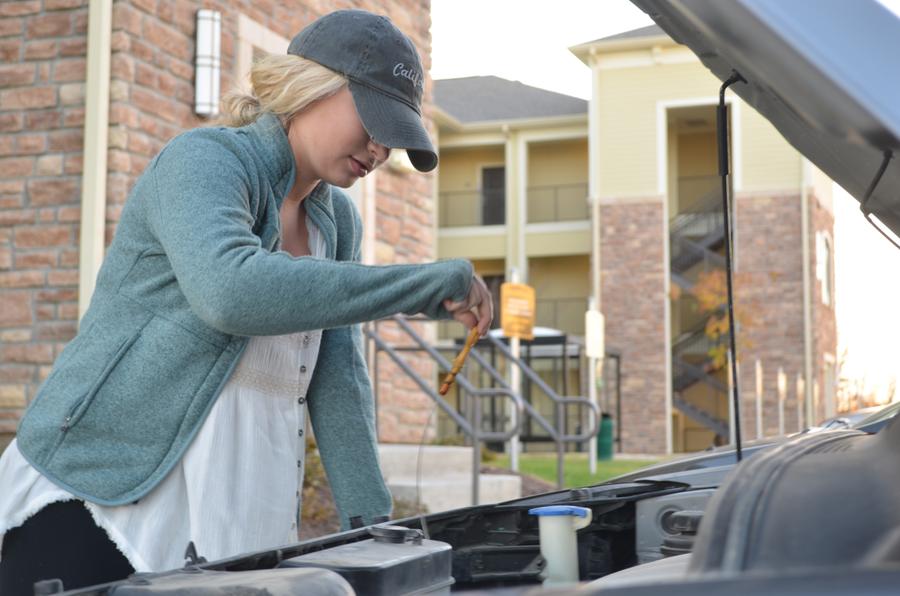I do not know a lot about cars, which is probably what worries my dad the most about me being in college. My car is sitting outside in lot AV-14, so Dad is concerned that something will happen to my Acura RDX to make it undrivable, whether it’d be caused by the winter weather or my sincere lack of knowledge about cars. So I asked him and my uncle about the most important things for a college student to know about cars.
1) The dropping temperatures cause tires to lose pressure, so if your tires look a little flat, fill them up with air. You can also check your tire pressure with a [tire pressure gauge](https://www.youtube.com/watch?v=wqLcxyTpVfA) before you go on a long trip to make sure everything is all right.
Pro tip from my cousin and longtime Columbia resident Matt Kinamore: There is an electronic tire pump at the Hy-Vee located at 3100 West Broadway that anyone can set to fill their tires to the desired pounds per square inch, the standard measure of tire pressure. The correct pressure varies from car to car. On average, it ranges between 30 and 35 psi, but you should check the owner’s manual for a precise measurement.
2) Speaking of flat tires, if a tire is underinflated, it is more susceptible to popping. If one of your tires pops, don’t panic. Your car might already be equipped with a [spare tire](https://www.youtube.com/watch?v=cSJc0jWiQdM), jack and wrench. Check your owner’s manual about whether your car is equipped with these items and where they are located. However, [some cars do not have them](http://publicaffairsresources.aaa.biz/wp-content/uploads/2015/11/Vehicles-Sold-Without-a-Spare-Tire.pdf). Instead, the car might have sealant and inflator kits or run-flat tires. Read the owner’s manual and make sure to know what your car comes with.
3) Check your oil. It’s pretty simple; there is a dipstick located near the engine that has the word “oil” on the top of it. You pull that out to check the gauge to see if the oil is full. If you need to add more, you can buy oil at any gas station. You should change your car’s oil after every 3,000 to 4,000 miles. Unless you know how to change a car’s oil, save this job for a mechanic. Oil changes can be scheduled, whereas popped tires or other emergencies cannot.
Pro tip from Kinamore: Check your oil before you start your car. Once you start your car, some oil can flick onto the dipstick and produce an inaccurate reading. If that happens, wipe it off with an old cloth, stick the dipstick back in and remove it for an accurate reading.
4) Check your windshield wiper fluid. This reservoir is usually white/translucent in color or is easily marked. Some cars might have a gauge on the outside that lets you know if it is full, but you might have to open the lid to check. If you are low, windshield wiper fluid can be found at most gas stations. Windshield wipers are very necessary this time of year because of all the snow or sleet a person may come across when driving home for winter break. If you notice that your windshield wipers are leaving streaks, and you find it hard to see when you’re driving in the snow or rain, it is time for new set of wipers.
5) Carry de-icer spray with you. If you have an older car and you have to insert your key in the door to unlock it, winter cold could make that difficult if ice freezes over the top of the key hole. Instead of having to wait around for the sun to melt it off, you can spritz the keyhole with de-icer, and the ice will melt away quickly so you can leave at the time you told your mom you would.
Bonus tip: Carry an emergency kit with you at all times in your car. Make sure it includes blankets, water, a first-aid kit, jumper cables and, especially this time of year, a bag of sand or kitty litter. If you are stuck on some ice and your tires can’t find any traction, pour some sand or kitty litter around them to help get you out.
_Edited by Katherine White | [email protected]_








